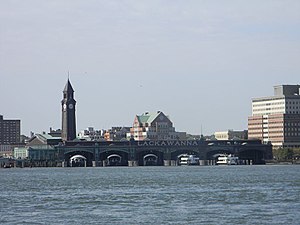
Back Terminal Hoboken Welsh Terminal Hoboken Spanish Hoboken (PATH) Basque Gare de Hoboken Terminal French ホーボーケン駅 Japanese Hobokenterminalen Swedish 霍博肯總站 Chinese
Hoboken | |||||||||||||||||||||||||||||||||||||||||||||||
|---|---|---|---|---|---|---|---|---|---|---|---|---|---|---|---|---|---|---|---|---|---|---|---|---|---|---|---|---|---|---|---|---|---|---|---|---|---|---|---|---|---|---|---|---|---|---|---|
 Hoboken Terminal from the Hudson River in 2012 | |||||||||||||||||||||||||||||||||||||||||||||||
| General information | |||||||||||||||||||||||||||||||||||||||||||||||
| Location | 1 Hudson Place Hoboken, New Jersey United States | ||||||||||||||||||||||||||||||||||||||||||||||
| Owned by |
| ||||||||||||||||||||||||||||||||||||||||||||||
| Line(s) |
| ||||||||||||||||||||||||||||||||||||||||||||||
| Platforms | 9 island platforms, 1 side platform | ||||||||||||||||||||||||||||||||||||||||||||||
| Tracks | 18 | ||||||||||||||||||||||||||||||||||||||||||||||
| Connections | |||||||||||||||||||||||||||||||||||||||||||||||
| Construction | |||||||||||||||||||||||||||||||||||||||||||||||
| Platform levels | 2 | ||||||||||||||||||||||||||||||||||||||||||||||
| Bicycle facilities | 88 spaces | ||||||||||||||||||||||||||||||||||||||||||||||
| Accessible | Yes | ||||||||||||||||||||||||||||||||||||||||||||||
| Other information | |||||||||||||||||||||||||||||||||||||||||||||||
| Station code | HOB 20496, 20497 (NJT Bus)[1] | ||||||||||||||||||||||||||||||||||||||||||||||
| Fare zone | 1 | ||||||||||||||||||||||||||||||||||||||||||||||
| History | |||||||||||||||||||||||||||||||||||||||||||||||
| Opened | February 25, 1907 | ||||||||||||||||||||||||||||||||||||||||||||||
| Electrified | September 3, 1930[2] | ||||||||||||||||||||||||||||||||||||||||||||||
| Passengers | |||||||||||||||||||||||||||||||||||||||||||||||
| FY23 | 6,875 (average weekday boardings)[3] (NJT) | ||||||||||||||||||||||||||||||||||||||||||||||
| 2023 | 4,856,642[4] (PATH) | ||||||||||||||||||||||||||||||||||||||||||||||
| Services | |||||||||||||||||||||||||||||||||||||||||||||||
| |||||||||||||||||||||||||||||||||||||||||||||||
| |||||||||||||||||||||||||||||||||||||||||||||||
Erie-Lackawanna Railroad Terminal at Hoboken | |||||||||||||||||||||||||||||||||||||||||||||||
 | |||||||||||||||||||||||||||||||||||||||||||||||
| Location | On the Hudson River at the foot of Hudson Place, Hoboken, New Jersey | ||||||||||||||||||||||||||||||||||||||||||||||
| Coordinates | 40°44′6″N 74°1′39″W / 40.73500°N 74.02750°W | ||||||||||||||||||||||||||||||||||||||||||||||
| Area | 4 acres (2 ha) | ||||||||||||||||||||||||||||||||||||||||||||||
| Built | 1907 | ||||||||||||||||||||||||||||||||||||||||||||||
| Architect | Kenneth MacKenzie Murchison | ||||||||||||||||||||||||||||||||||||||||||||||
| Architectural style | Beaux-Arts neoclassicism | ||||||||||||||||||||||||||||||||||||||||||||||
| NRHP reference No. | 73001102[5] | ||||||||||||||||||||||||||||||||||||||||||||||
| Added to NRHP | July 24, 1973 | ||||||||||||||||||||||||||||||||||||||||||||||
Hoboken Terminal is a commuter-oriented intermodal passenger station in Hoboken, Hudson County, New Jersey. One of the New York metropolitan area's major transportation hubs, it is served by eight NJ Transit (NJT) commuter rail lines, an NJ Transit event shuttle to Meadowlands Sports Complex, one Metro-North Railroad line, various NJT buses and private bus lines, the Hudson–Bergen Light Rail, the Port Authority Trans-Hudson (PATH) rapid transit system, and NY Waterway-operated ferries.
More than 50,000 people use the terminal daily, making it the tenth-busiest railroad station in North America and the sixth-busiest in the New York area. It is also the second-busiest railroad station in New Jersey, behind only Newark Penn Station, and its third-busiest transportation facility, after Newark Liberty International Airport and Newark Penn Station.
The rail and ferry terminal buildings were constructed in 1907 by the Delaware, Lackawanna and Western Railroad, a former Class 1 railroad. In 1930, Thomas Edison was at the controls for the first departure of a regular-service electric multiple-unit train from Hoboken Terminal to Montclair. In 1973, the terminal building was added to the New Jersey Register of Historic Places and the National Register of Historic Places.
Hoboken Terminal is considered a milestone in American transportation development, initially combining rail, ferry, subway, streetcar, and pedestrian services. Later, bus and light-rail services were added to the terminals. Another feature of the terminal's design is the terminal's 225-foot (69 m) clock tower. The tower was replaced by a radio tower that stood for more than half a century, until being removed in June 2006,[6] when it was replaced with a new clock tower modeled after the original.
- ^ "Station Area Map, Hoboken Terminal" (PDF). NJ Transit. November 2017. Retrieved April 2, 2020.
- ^ "D.L.&W. Electric Train Hoboken to Montclair". The Madison Eagle. September 5, 1930. p. 6. Retrieved January 31, 2021 – via Newspapers.com.

- ^ "NJ TRANSIT FACTS AT A GLANCE". NJ Transit. Retrieved July 3, 2024.
- ^ "PATH Ridership Report". Port Authority of New York and New Jersey. 2024. Retrieved July 3, 2024.
- ^ "National Register Information System". National Register of Historic Places. National Park Service. March 13, 2009.
- ^ Stessel, Dan. "NJ Transit To Begin Rebuilding Clock Tower At Hoboken Terminal". njtransit.com. Retrieved February 10, 2023.